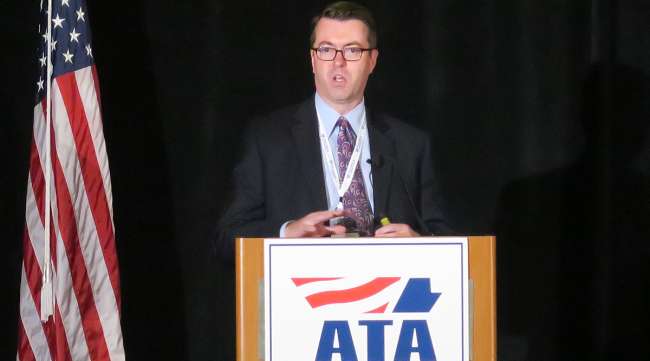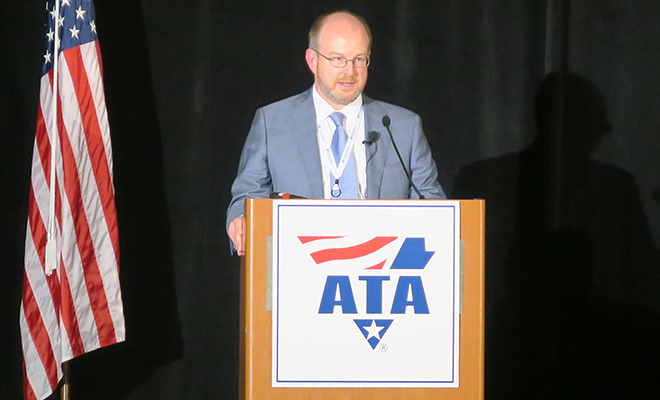Bright Outlook for Industrial Sector, Economists Say at Summit

Business conditions have rebounded in 2017 for companies involved in manufacturing and commodities, and the outlook remains positive for the industrial sector, according to economists at the inaugural American Trucking Associations Economic Summit.
The Institute for Supply Management’s manufacturing index in June was 57.8%, the highest level in 2017 and better than the 52.8% in June 2016. The average monthly level this year has been 56.4% compared with a 51.5% average for the full 2016. Any level above 50% signifies manufacturing is expanding.
“Capital spending has a 3.2% growth average over the next 12 months, employment 2.7% growth. Trends are clearly going in the right direction. Even sales and production numbers are just shy of 5% growth,” said Chad Moutray, chief economist for the National Association of Manufacturers. “When you compared conditions with where we were six or 12 months ago, those are really strong numbers.”
The group’s monthly manufacturing confidence survey was about 90%, a soft data point that he called “encouraging.” Soft data refer to numbers based on opinions, feelings or sentiments, whereas hard data consists of numbers based on action.
Similar to the ATA tonnage index, NAM’s hard data has seesawed this year. Manufacturing production rose 0.2% year-over-year, mostly attributed to durable goods. Through June, manufacturing is up 1.2% and industrial production — manufacturing, mining and utilities combined — rose nearly 2% compared with the first half of 2016, Moutray said.
“It’s hard not to be bullish about manufacturing in the U.S. right now,” he said. “We’re attracting a lot more investment, much of it from chemicals, but there’s also some from the automotive and aerospace categories. I think that’s going to continue because technology will make things more efficient and fundamentally change the way we think about manufacturing.”
Thomas Kevin Swift, chief economist at the American Chemistry Council, echoed the positive sentiments and predicted that oil and natural gas production will increase 5% to 8% through 2020. He said his forecast was based on energy companies that chose to build oil rigs from 2012 to mid-2014 when prices of West Texas Intermediate crude hovered near $100 per barrel. Structures designed during that period are coming online now and in the coming years.
“We expect very, very strong growth on the supply side. Strong through 2020 and then a small lull after that,” Swift said. “Going forward, markets are saying that we’re still going to be competitive as you go into the 2020s.”
ATA’s long-term annual economic forecast found the rapid rise in domestic petroleum demand will lead to a 7.9% compound annual growth rate in the use of pipelines and raise their share of the commercial transportation market from 10% to 17.5% by 2028.
“Strong growth in U.S. natural gas production, increased supply from Canada and anticipated expansion of U.S. chemical industry’s ethylene capacity are expected to result in additions to pipeline capacity in the years ahead. We expect pipeline to be the fastest-growing mode through 2028,” ATA Chief Economist Bob Costello predicts.
Truck transportation will drop from a 70.6% market share to 67.2% by 2028, although it will remain the predominant mode.
Domestic steel shipments also reversed course from a slide that began last autumn. Annual steel mill shipments tumbled 11.9% in 2015 and remained flat in 2016, but they have grown 4.2% this year and increased year-over-year in seven consecutive months, the American Iron and Steel Institute reports. Chief Economist Timothy Gill attributes the turnaround to manufacturing, natural gas, crude oil, construction and an anti-dumping crackdown on Chinese imported steel.

Gill by Joseph Terry/Transport Topics
“The capacity utilization of mills, which was as high as 80% in mid-2014, fell dramatically over a few quarters to a low of around 60% in the early part of last year and that’s not consistent with a healthy industry,” Gill said. “Since then, it’s climbed back in a positive direction. We we’re close to 76% utilization for the week ending July 15. The number is similar for the year-to-date.”
Nevertheless, the outlook from the industrial sector hasn’t translated to dry van yet, but it’s benefited flatbed carriers. Costello said flatbed loads were up 5% year-over-year in 2016 and year-to-date in 2017. However, dry van and refrigerated segments are flat year-to-date, although carriers have told Transport Topics that freight activity picked up in the past six weeks.
While Costello’s long-term economic forecast calls for a 33% rise in freight volume to 13.9 billion tons by 2026, the pace of growth will slow.
“We have gone from a period where trucking volumes grew at [gross domestic product] or better on average to a period now where we will not grow as fast as the overall economy on average. Freight is going to grow, but as an industry we have to realize we won’t grow as fast as the macroeconomy anymore,” he said. “We’ve had a miniaturization of freight. Think about all the widgets and stuff we’re buying and how much smaller they’re getting. One carrier said to me ‘I used to put 100 TVs on a trailer, now I put hundreds of TVs on a trailer.’ ”




